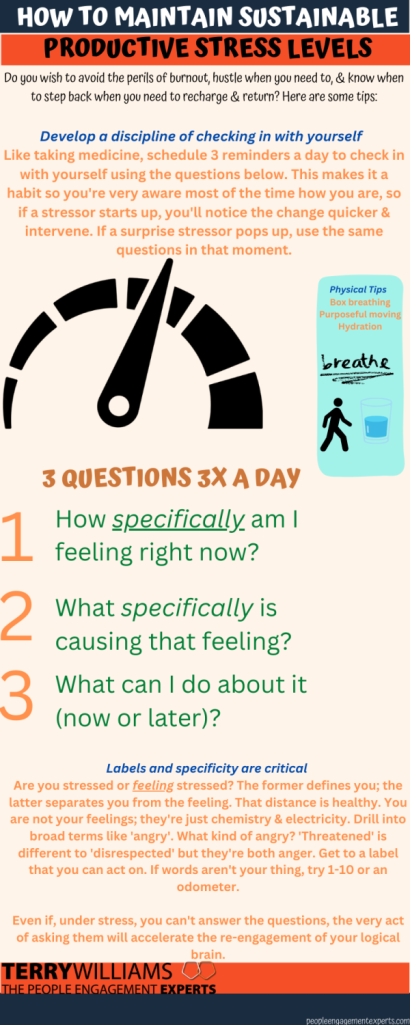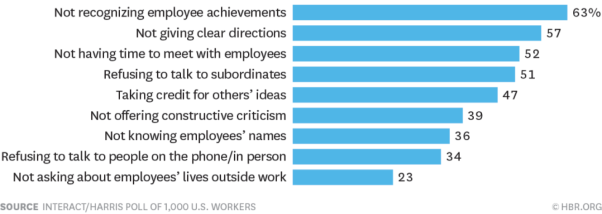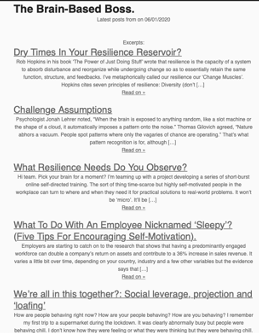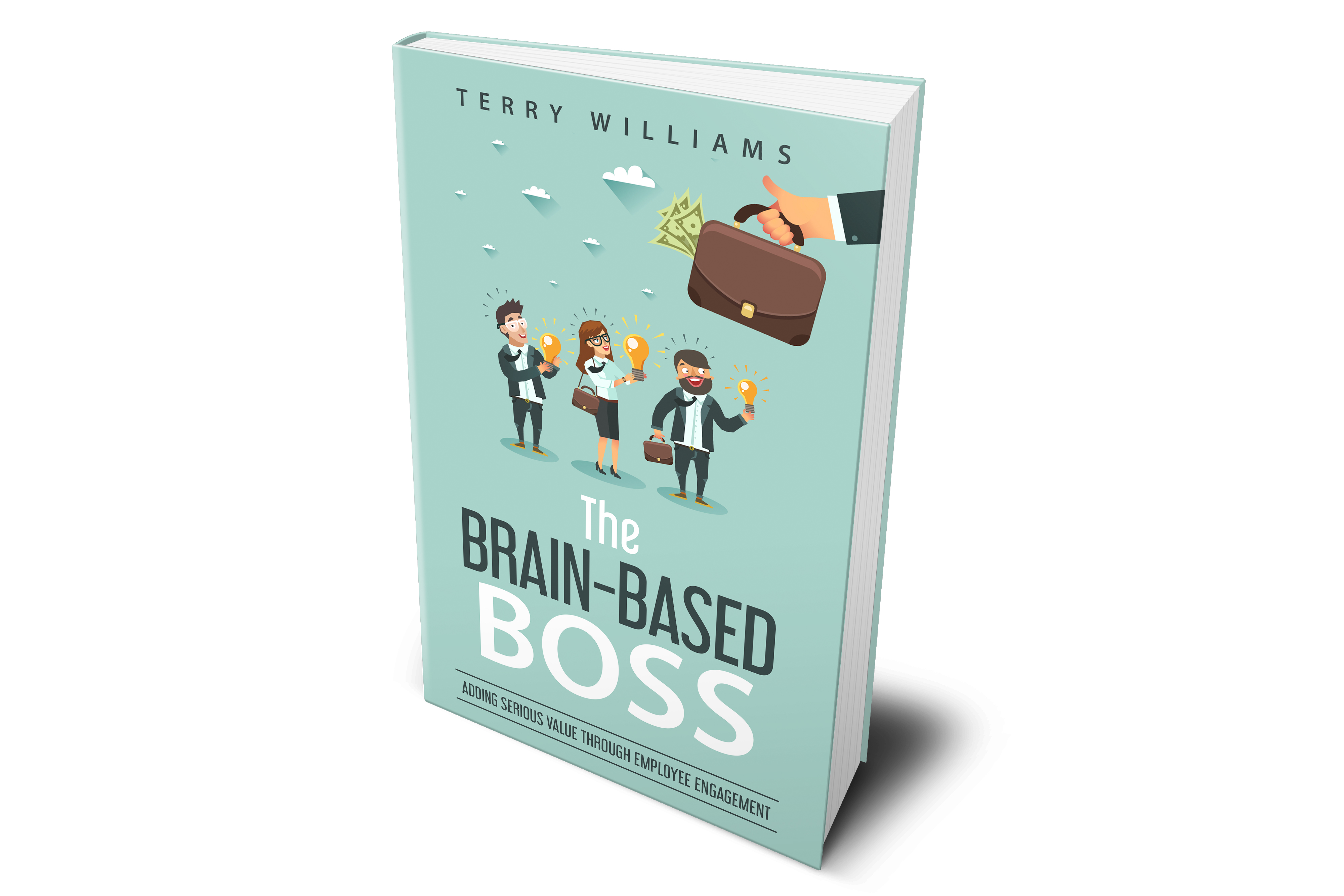Blog Archives
Navigating Volatility: How to Maintain Productive Stress Levels in Yourself and Your Team

(Sign up for this newsletter in future via LinkedIn here: https://www.linkedin.com/newsletters/getting-better-buy-in-7018707415135117312/ )
New Zealanders are currently facing a number of challenges in this volatile environment. Never mind the economy, the recent flooding and cyclone (and its ongoing structural, social, and psychological aftermath) has drained energy, time, attention, and resources from business as usual, and the shortage of talented people has made it more difficult for firms to meet their staffing needs. At the same time, it’s important for individuals and teams to maintain productive stress levels, as stress can impact mental and physical health and lead to decreased productivity. (And, of course, just being decent human beings. I’m focusing on workplace productivity because that’s what I do but the decency thing I hope goes with saying. That said, I said it).
I’m going to overview the challenges faced by firms and the importance of maintaining productive stress levels – to get on top of them before they get on top of you. The recent climate catastrophes created disruptions to business operations and increased stress levels for individuals and teams. The shortage of talented people has made it more difficult for firms to meet their staffing needs, leading to increased pressure and workloads for existing employees. The volatile environment can create uncertainty and add to existing stress levels. It’s important for both individuals and teams to maintain productive stress levels, as stress can impact mental and physical health and lead to decreased productivity. Some of the effects of stress on individuals and teams include:
- Decreased motivation and engagement
- Increased absenteeism and turnover
- Decreased creativity and problem-solving skills
- Decreased work quality and productivity
By proactively addressing these potential effects, individuals and teams can maintain their health and productivity, and better navigate the challenges faced by New Zealanders.
If this sounds heavy, here’s a pic of our new puppy Toby Batman:

I’ll cover all this in broad terms shortly but the key takeaway in this newsletter is a little technique that I’ve found incredibly powerful in recent years, both personally and professionally. It wasn’t put together with the floods in mind but it suits this time well. I include it in several workshops I run. The ‘Sustainable Stress’ 3-Question technique is summarised in this infographic.
This mission of this monthly newsletter is to capture and distribute what we at The People Engagement Experts have picked up that passes as wisdom in a form that is directly practical and useful. What trainers like me might call ‘takeaways’. Things like infographics, checklists, and templates. Books, presentations and training courses are great (as an author, speaker & trainer, I would say that) but most days they’re a bit much and people have work to do. This newsletter will feature one short-form tool each month. This month, it’s the ‘Sustainable Stress’ 3-questions technique above.
Stress is a normal part of life and can occur in response to various situations, including work, relationships, and events such as the recent flooding and cyclone. While some stress is normal and can even be helpful in motivating us to complete tasks, chronic stress can have a negative impact on our mental and physical health. Chronic stress can lead to symptoms such as fatigue, headaches, irritability, and difficulty sleeping, among others. The stressor aftermath of the floods is going to remain long after the waters recede.
In the workplace, stress can be caused by a variety of factors, including heavy workloads, tight deadlines, workplace conflicts, and the recent flooding and talent shortages. The current volatile environment can also contribute to stress and uncertainty, as employees may worry about their job security, the future of their firm, and other work-related concerns.
It’s important to recognise when stress levels are becoming problematic and take steps to manage it. By doing so, individuals and teams can improve their mental and physical health, boost their productivity and creativity, and better navigate the challenges they are facing. This can also benefit the overall health and success of the firm.
Self-care is an important aspect of managing stress levels and is crucial for maintaining both mental and physical health. Taking breaks throughout the day, even just for a few minutes, can help to reduce stress and recharge the mind. This can involve activities such as taking a walk, reading, or engaging in a hobby.
Mindfulness and relaxation techniques can be effective in reducing stress and promoting mental well-being. This can include practices such as meditation, deep breathing, and yoga. These activities can help individuals to focus on the present moment and release pent-up tension and stress.
Setting boundaries and prioritising tasks is another effective strategy for managing stress levels. This involves setting realistic expectations and creating a manageable to-do list. By focusing on the most important tasks and delegating or postponing less critical ones, individuals can avoid feeling overwhelmed and reduce stress.
Physical activity can play an important role in reducing stress levels and improving overall health. Regular exercise can help to release tension, improve mood, and promote better sleep, which can all help to reduce stress levels. Whether it’s through structured exercise such as going to the gym or a more relaxed activity such as taking a walk, incorporating physical activity into daily routines can be beneficial.
Open and effective communication is key in managing stress levels within teams. Encouraging active listening, where individuals listen and respond to each other’s concerns and needs, can help to build trust and reduce stress. Regular team check-ins can also provide opportunities for team members to discuss their concerns and provide support to each other.
Encouraging self-care and breaks for team members is an important aspect of managing stress levels within teams. This can include activities such as taking short breaks throughout the day, practicing mindfulness, or engaging in physical activity. Providing resources such as flexible schedules or time off for self-care can also be beneficial.
Providing support and resources to team members can also help to reduce stress levels within teams. This can include offering mental health resources, providing access to counselling services, or offering workshops and training on stress management techniques. Providing support can help individuals to better manage stress and improve their overall well-being.
Creating a positive and supportive work environment is also crucial in managing stress levels within teams. This can involve creating a culture that promotes collaboration, teamwork, and open communication. Encouraging team building activities and fostering a sense of community can also help to reduce stress levels and create a positive work environment.
I’ve discussed the challenges in the current volatile environment and the importance of maintaining productive stress levels for both individuals and teams. I’ve covered strategies for managing personal stress levels, including self-care and mindfulness, as well as strategies for managing team stress levels, including communication and support.
It is important for senior leaders to address stress levels within their teams in order to maintain productivity and well-being. Addressing stress in a proactive and supportive manner can help to improve the overall health and satisfaction of employees and ultimately contribute to the success of the organisation.
Senior leaders play a crucial role in addressing stress levels within their teams and creating a positive work environment. By getting onto the ideas I’ve covered, senior leaders can help their teams to better manage stress and maintain productivity in a volatile environment. We encourage senior leaders to take action to address stress levels within their teams and make a positive impact on their employees and organisations.
Have a crack at the 3-questions technique. Try to make it a habit. It really enables you to take control of stressors rather than them taking control of you. Let me know how you get on.
If you found this interesting or helpful, please share on LinkedIn (And beyond!)
Download your free eBook version of ‘Getting Better Buy-In’
Enquire about our training, presenting, or coaching services
Who Leads The Leaders?

Studies into the characteristics of highly effective leaders find that ‘vision’ is usually at the top of the list of characteristics. Any individual moving others to sustained and purposeful action would need to be future-facing, goal-setting and inspirational. All that requires an ‘eye on the prize’. There are many leadership phrases using eye-imagery. I’d like to add another: point of view.
A couple of my own recent experiences have hit home to me the power of point of view to stunt or stimulate leadership, to send it in a direction that may turn out in ‘hindsight’ to be right or wrong, better or worse.
I attended a seminar lead by a scientist concerned about ethical leadership in science, specifically designing in ethical considerations within artificial intelligence systems (AI). The people doing the designing are very public in declaring that ethical filters and values will be designed into the systems. Less overt and public are exactly what ethics are being designed in. It’s stated almost as if ethics are ethics and yours are the same as mine so, as long as the AI has ethics, then we’ll be fine. Ethics are a lot like cheese. The stuff you find acceptable might be offensive to me and a significant minority of people are dairy intolerant.
This scientist was calling for more diverse points of view. A video montage of the scientists making a lot of noise and getting a lot of attention around AI did seem to be entirely of a certain age range, nationality and gender. Ethics are hard enough to get some agreement around within a family of four humans. Once you start bringing robots into the equation, it’s complicated and diverse points of view would help.
I’ve been running a series of diversity workshops for a large and established manufacturing firm, mostly around unconscious bias. The firm for the most part has a great track record with diversity. The workshops are a regular United Nations. However, they are behind the eight-ball on gender diversity. They know this and they’re trying. They know what the AI scientists might be a bit late in realising – the dangers in having a highly homogenous worldview – opportunities lost and threats unrecognised. Their customers are diverse. Their community is diverse. Yet, things historical and structural are hamstringing their efforts to counter the imbalance. In short, women aren’t applying for the jobs or those women don’t exist yet.
Most of the AI online customer service ‘robots’ I’ve seen have been given female personas. I don’t know why this is. Statistically a disproportionate number of human frontline customer service roles are female. Maybe the designers took that into account? What proportion of the designers were male? Does it matter? The newer AIs are now quite adept at recognising emotion in the voices and expressions of their customers and adjusting their responses accordingly.
You’re not designing terminators with emotional intelligence. You’re an employer. Maybe you’ve already got balance and diversity in your workplace overall. But, how is it like at the leadership level? What systems, checks and balances do you have in place, now and for the future that will ensure leaders have, develop or access diverse points of view? If through randomness or statistics, you’ve just ended up with a bunch of leaders in your organisation who are all big fans of the Eagles and Fleetwood Mac, there’s a real chance that they’re lacking diversity. But, if you’ve got the right systems and tools, they need not act like it. While you and the world are catching up and eventually defeating glass ceilings and velcro floors, your leaders can still make good leadership decisions. Train and coach them. Provide them with tools. What’s important for each organization is to identify the relevant dimensions, measure them, and make that part of how managers are evaluated. If you want diversity of thought, you have to bring in people around leaders who have diverse experiences. In the meantime, you can ask questions to capture and codify those experiences so the leaders you have at the moment can filter their decisions through those different points of view.
One of my catchphrases for the year has been, “The person who asks the questions controls the conversation”. I’ve been doing a lot of reading around the relative effectiveness of telling people stuff versus asking questions. I like to call the latter ‘structured curiousity’ ABC – Always Be Curious.
The irony here is back with the topic I started on – AI. Experiments have already been done with people reporting to on-screen AI personas. They’re not perfect but they have two skills many current human leaders lack. They do ask questions and they are capable of recognising emotions and adjusting their actions accordingly. These two skills alone would put them in the top 25% of bosses I’ve ever had.
_____
My presentation on change and risk is 2dangerousthingsayear.com
Video series: www.brainbasedboss.com
More ideas at http://gettingbetterbuyin.com/
Empty Nesting

Both my kids left home this past week. They’ve done it before. They may do it again. It’s not quite like a generation or two ago when leaving home was a definitive cut-off and a one-way trip. These days there’s the term ‘boomerang kids’ for those who keep coming back (no matter how far you throw them). And, apparently, in Italy they never leave.
They first left home a year ago to go to university in a different city but they were staying in halls of residence and they were together – regularly checking in with us, and back each term break. Given how much time they used to spend out or in their rooms, it really didn’t seem that different. This time round it seems more real. They’re flatting separately and we’re now also missing things from our house as well as them. Still, how many frying pans does one really need?
Also- that’s two drivers off Auckland’s roads lessening our household’s contribution to the congestion by 50%. I challenge all other Auckland households to do the same. Hey, Auckland Transport, I’ll expect some congestion charge discount in your planning thanks.
In my new presentation about change and how to build resilience in anticipation of inevitable if unpredictable change, I briefly reference the Sigmoid Curve. It’s an oldie but a goodie as a mental model for understanding natural processes and lifecycles. Originally noticed in the world of nature, it’s subsequently been applied to lifecycles of products, organisations, societies and relationships. Picture a seed and its growth as a graph. Initially growth is negative as it gears up and stores resources for the big sprouting then it shoots and grows up to a peak then declines then [spoiler alert] some terminal point.
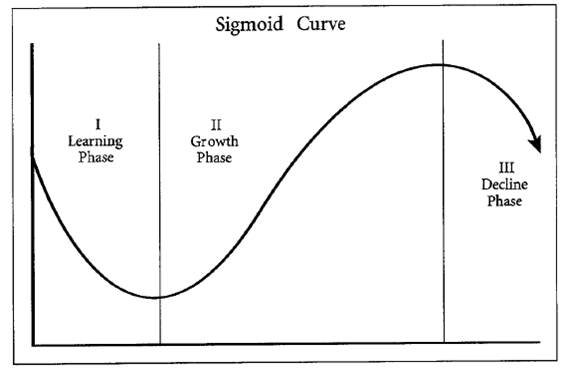
The trick, experts say, is to pick a point before the decline and either start another curve or reinvent the current one so that it is, in effect, a new one. Timing is important as you need the resources to begin again and no one is giving resources to a declining curve.
I want to make the analogy to work teams, using both the kids leaving home and the Sigmoid Curve.
As fast as two decades of parenting has zipped by, the change in our home ‘team’ was inevitable, even if the specific circumstances and timing were unpredictable. This is true in work teams and at a much faster rate. I led one group for over a decade and one of the things of which I’m most proud was that at the time of the initial recruitment and building of my team, I was also developing plans and processes for the inevitable reinvention of that team. It did take longer and I didn’t HAVE to do it, but within only a few months my righthand person had to quit and go overseas due to a family health crisis. I was ready and whilst surprised and supportive, I wasn’t shocked – family health crises happen. Not only was I able to instantly implement plans to temporarily and permanently replace that person, I was able to have that person involved in the process, thus helping me out and giving them a lessened sense of guilt and a heightened sense of closure.
One of the most dangerous phrases in business and life is, “If it aint broke, don’t fix it”. That’s super naive and dangerously unrealistic. I”m not saying deliberately break things (although I”m not saying not to do that) but we all have a spare tyre in our cars because a flat tyre is inevitable. We try to save a bit of money and have a few spare frying pans and advice for when our kids leave home. So, regardless or perhaps because of, how optimal you think the team you’re leading right now is doing, start prepping for the inevitability of change and someone – a key person – leaving the nest.
——
Check out my new motivational presentation at http://www.2dangerousthingsayear.com
More ideas at http://gettingbetterbuyin.com/
To what extent are you seeing what you want to see and disregarding the rest?

Meta-cognition is a fancy term for thinking about how we think. We don’t often do it because we’re all so caught up in actually thinking or, more probably, doing stuff with as little thought as possible. (I might be judging myself on that point). The mindset and beliefs we have got us to this point and if this point is OK or better, there are risks in changing and challenging. But things won’t get better if you don’t.
In short, one answer is to deliberately surround yourself and seek out and expose yourself to information sources that you know will challenge you. I’m not suggesting you live in a perpetual state of stressful heightened awareness and self doubt but at the very least you gotta have someone who’ll call you out. Diversity is the broadest sense is even better. Source from beyond your bubble.
You won’t have time to think about everything, after-all that’s why you revert to confirmation bias to begin with, but perhaps approach conversations with an open mind. Don’t be so quick to judge.
Surround yourself with different types of people. Don’t label yourself. Be well-rounded and willing to hear different types of opinions on politics, religion, and life in general. This is a sign of intelligence not passivity.
It takes incredible mental strength to challenge your own deep-seated beliefs. Stand by your convictions, of course, but just realize some of that just may be rooted in confirmation bias. Be open. After-all. life is full of the gray stuff. We wish it were simple. This is right. That is wrong. It doesn’t always work that way. That’s why it’s good to be aware. Self-aware.
This article explains confirmation bias and some more thinking around addressing it.
– – – – –
More ideas at http://gettingbetterbuyin.com/
Performance Management Moneyball

I’ve been following NBA basketball pretty intently for thirty five years. These days I watch games in high-definition on any one of a number of devices via an online streaming or on-demand subscription service the NBA provides me. You know who else is watching that same footage and has access to the same stats and more in real time? The players!
We probably couldn’t see it in 1982 because of collusion with broadcasters or just the terrible quality of analog broadcasts in the 80s but players were probably smoking and drinking on the bench during games. Maybe they were trying to blend into 80s society? I can’t say they were for sure as I wasn’t there but I can’t say for sure that they didn’t. In 2017, modern players all sit each with their own individual tablet device provided by the team with close-to-realtime videos relating to their own performance, accompanied by statistical breakdowns on the team generally and them specifically. No one is smoking or drinking and if anyone so much as opens a bag of skittles, they’ll likely get fined and sent to make an appointment with a counsellor, then attend a restorative justice session for any members of the team who were emotionally triggered by the insensitivity.
Kiwi Steven Adams is doing well in the NBA for the Oklahoma City Thunder. He, and we, could simply assume so based on his recently formalised nine-digit contract. A nine digit contract!? I barely have that many digits on my hands. Salary in pro sports, as in any other job, is no real gauge of performance. As pro rugby players do, even in little old New Zealand, Adams wears a device within his uniform as he runs up and down the court and it measures much more than the official game stats and transmits that information to where it is automatically and instantly collated and compared and returned as multi-media reports to Adams, his coaching team and the management, who ultimately sign off on contracts.
There is a correlation between easily measured metres run and success at basketball worthy of reward. It’s not everything. If he was a disruptive influence in the team, talent notwithstanding, he could be cut or traded. A Lakers player who thought it would be hilarious to tape one of his teammates confessing to cheating on his popstar wife, then putting it on social media is no longer a Laker. He is now with the Brooklyn Nets – a team with one of the worst 3-year stretches in the history of the game. Karma baby.
The Nets’ GM is Sean Marks. He’s a kiwi – New Zealand’s first ever NBA player and now an executive on the up. When you have a job that is historically on the bottom, the only way is up. He’ll have performance measures of his own in place. The team is owned by a Russian billionaire and they’re famous for feedback. Could marks’ performance be managed as clinically as Adams’?
If we’re talking about performance management in work generally, the underlying foundation ultimately is measurement of the actual level of performance and comparison to an expected level of performance. Ideally, these would be as objective as possible and for some jobs that is challenging. Basketballers can count points, rebounds, assists and a variety of other easily measured things. Historically, some players on poor teams on the last year of their contract did something called ‘padding their stats’. They put their own interests ahead of the team to make their numbers look good. I’ve worked in a couple of places where sales folk did similar things. The nature of the measuring of performance drove behaviours that gamed the system.
Nowdays, with moneyball execs and algorithms and such, there is a basketball measure called ‘Real Plus/Minus’ that, whilst not perfect, does a fairer and more accurate job of ‘scoring’ a player’s actual contribution to the success of the team. Fans can see in realtime and players at the next timeout the difference their efforts are making or not. How do you think that might impact the performance of average working people in more mainstream jobs, like plumbers, contact centre reps or cheesemaker? I have a sideline as a comedian and that is the most well performance managed job on Earth. For a start, it is literally (and I literally mean literally) a performance. If they laugh that’s good feedback. If they don’t laugh, that’s also good feedback. It’s instant, it’s honest and it’s independent.
Real Plus/Minus is complex to calculate and only started in 2014. Not all coaches love it. Some stick to their subjective ways. Prior to that, coaches and scouts had to look at whatever numbers that were available, then think about how they felt about that player and their contributions to productivity. And on that, players were judged. How confident are we that most managers of work performance don’t manage performance like meteorologists of old, licking a finger and waving it in the wind?
More ideas at http://gettingbetterbuyin.com/
Why do some people micro-manage?

I ran a couple of workshops this week on effective delegation with a law firm. I’ve also run these many times with many non-law firms. There’s a point after we agree on a definition of what delegation is, then discuss the potential benefits and differing objectives delegating might purposefully achieve if conducted effectively in a structured and tailored way. Right after that we tackle the reasons, justifiable or otherwise, why some people might choose not to delegate, or to do so ineffectively (whether or not those people were even consciously aware of why they were doing so).
Earlier, I’d sought from participants real-life stories from their own experience or observations of instances they considered to be effective and ineffective delegation. This week, as always, the vast majority of ineffective and unfortunate examples involved actions that could be encapsulated as ‘micro managing’.
We’ve all been there.
My own story was being lectured and berated on my sweeping technique in a building supply warehouse in which I worked in the mid 80s. I’m certainly over it but even in the retelling, I still get a hackle-raising sense of frustration in my blood. Others shared similar tales from their own back-stories.
One of the major reasons the groups self-identified behind people choosing to either not delegate or to pretty quickly start sticking their oar in again was to do with time and perspective.
If all you’re focused on is today and the ticking clock of a deadline, it may well be true that you can do it better and quicker yourself rather than delegating it. But if you’re focused on the big picture and the long game, you’re more open to realising and accepting that the point of delegating isn’t just about getting this piece of work done as soon as possible. It’s about getting many more pieces of work done again and again constantly. It’s a false economy to try and fool yourself that hanging onto tasks that could be done by others is effective leadership, simply because this one time you beat the buzzer. There are many more pieces of work than you are physically and mentally incapable of doing. It’s a simple capacity issue – if you’re focused beyond today. Delegating isn’t about flicking a task or two to the lowest-cost grunt able to competently do it, it’s about building capacity in your team in a planned, measured and deliberate way. Quite apart from getting stuff done, it exposes different people to your clients, builds trust, identified problems and mistakes early enough to rectify them, creates skills for succession planning and developing cover. If only one person can do a particular task and they get hit by a bus, or leave, or set up in competition, that’s a poorly managed risk.
Some people naturally have a time focus on the immediate short-term; others naturally look down the line a bit. The group had some ideas about how to not rely on nature, logical argument and luck to nudge the mindsets of those those now-fixated folk into the future a bit. One was around stories – not dissimilar to Scrooge and the ghosts of Christmas past and present. If micro-managing leaders can be exposed to leaders who used to be like them but saw the light, or that light they saw was the fire that burned them, them some lessons can be passed along forming organisational learning and memory. And everyone benefits, maybe not today but soon enough. And the sooner they start, the sooner it’ll happen.
– – – –
More ideas at http://gettingbetterbuyin.com/
How Can You Make Your Own Luck When It Comes To Recruiting And Retaining The Best Employees?
This recent article in the business section of the New Zealand Herald cites research conducted by a firm of recruitment consultants. I’m not suggesting for a moment that they have a vested interest in interpreting the results in any particular way, but they interpret the results in a particular way… that says employers aren’t recruiting effectively. (If only there was someone around who could help them?)
Sarcastic and cynical as I am, I’m not disputing the results of the survey – just their narrow interpretation of the cause. There’s never ONE cause. Maybe poor recruitment contributes. I bet it does.
The Hudson survey “paints a bleak picture for employers”, saying: “Of every 10 employees: four are not good hires, eight aren’t engaged in their work and six are actively seeking other employment.” Ouch! This is born out by other research I’ve been reading over years and around the world. There’s a bit of variation, mostly by industry, but this survey isn’t that surprising and New Zealand isn’t that bad. Nevertheless, there’s plenty of scope for improvement.
Apart from the recruitment tools being used which the recruitment company focuses on, the primary cause of the problem implied is that employers are recruiting almost entirely for skills – technical skills. It’s that old mindset of, “I’ve got a vacancy, I’d better fill it because it’s costing me money” without doing the correlating maths on how much it costs to fill that vacancy and get it wrong – to fill it with someone technically competent (and that’s even assuming they get that bit right) but quickly disengaged or a misfit in several other ways.
Bad luck? Like most games, you make your own luck in the recruiting game. I was meeting recently with a manager who hadn’t had a single instance of negative turnover for nine years. Yes, people had moved on but for the right reasons such as internal promotion. He used the usual suite of tools to find a pool of potential applicants, whittled them down through CV checking, interviews, reference checks and even the occasional behaviourial profile. But he added another step. Shortlisted applicants all got to sit in on some actual work with some people who, if their application was successful, would be their co-workers. Those co-workers got a right of veto. I used this myself in the past with some success in a call centre that wasn’t a typical call centre. It gave applicants a dose of what their potential working reality could be. Sometimes they got put off by us and our work; sometimes we got put off by them. Either way, it’s better for both parties that be known early and up front so neither employer or employee have to suffer the consequences of misfitting. And those are greater than the costs of vacancies.
Another means of increasing your odds is to encourage referral of potential applicants from existing employees. Some firms even offer a commission for this. BUT if you do that, ponder how this might affect behaviour and what exactly it is you’re wanting to incentify and provide commission on. Any commission should be for a successful applicant who is still there after a predetermined period and performing well. Not just for putting someone with a pulse into a vacancy. Rather than just advertising to the great untargetted masses for your specific vacancy, wouldn’t it increase the chances of success if you sought via an informed gene pool – the people who are already aware of what it takes to do the job and who is likely to prosper there?
Wringing the final life out of my luck metaphor, when it comes to those few shortlisted candidates who are demonstrably technically competent but you’re not absolutely certain that they’ll fit and be engaged, you’ve got to know when to hold ’em, know when to fold ’em, know when to walk away, know when to run. Often it’s better to walk away and play another day. Cheaper in the long run even if baby needs a new pair of shoes.
***
Re-blog from Nov 2011 & my most read post ever
The Communication Issues That Prevent Effective Leadership (According To Employees)
I found a short and snappy graph today about where workplace leaders are supposedly falling short. This is from the US, is a survey of a thousand workers and I haven’t delved into its methodology at all but it might be a conversation starter. It asked employees but it was clearly offering a pre determined list of options – I’m pretty sure someone isn’t going to refer to themselves as a “subordinate.” Myself, most days, I feel at least ordinate.
I’ll probably trial this in the communication workshops I run. I might give my participants that list (without the results) and ask them where they think most managers fall short, or where their own manager falls short, or where they feel they themselves fall short, or all those things. Then reveal the results. To start a conversation.
Pretty shocking that 36% result for bosses not knowing their own employees’ names! (Employees now, not subordinates. Consistency please.) I’m self-employed and I manage to remember my employee’s name.
Employee Engagement Requires More Than Caring Bosses
 This blog post makes a clear demarcation between the behavior of bosses that can enhance employee engagement and the lazy assumption that it must all be about being nice and friendly and a soft touch.
This blog post makes a clear demarcation between the behavior of bosses that can enhance employee engagement and the lazy assumption that it must all be about being nice and friendly and a soft touch.
I’m seemingly forever clarifying to people that employee engagement is not synonymous with employee happiness or morale or satisfaction. They’re all nice things. They’re all interesting. We’d all probably like to work in a job where there are higher levels of happiness, satisfaction and morale. BUT employee engagement is a very narrowly defined phenomena – the application of discretionary effort. It isn’t about how workers feel or think or think they feel. It is about how we observe they behave. To what extent do they do more than they have to because they choose to – for whatever reasons? It’s not about evil, moustache-twirling villainous bosses extracting everything they can and more out of labour. It is about people’s fundamental human, psychological needs and how they are served (or not) in their work.
Our jobs need to be about more than a paycheck. We take a job for the money but how we perform once we’re hired is less about money than managerial wisdom has thought for years.
And it isn’t about bosses being ‘nice’ or a soft touch. I can get my own hugs thank you very much. A boss who, on the surface, may seem ‘un-nice’ or uncaring might actually be driving high levels of engagement in the people they lead. Regardless of their cliche and superficial people skills, if they can stimulate a sense of purpose in their people, backed up with allowing some degree of autonomy and provide a track for development and progression, then that goes a long way to enhancing engagement levels and the benefits that ensue for productivity and profitability.
But if you still want hugs – get a dog. A big one. I recommend a huntaway. Way less employment court consequences.
